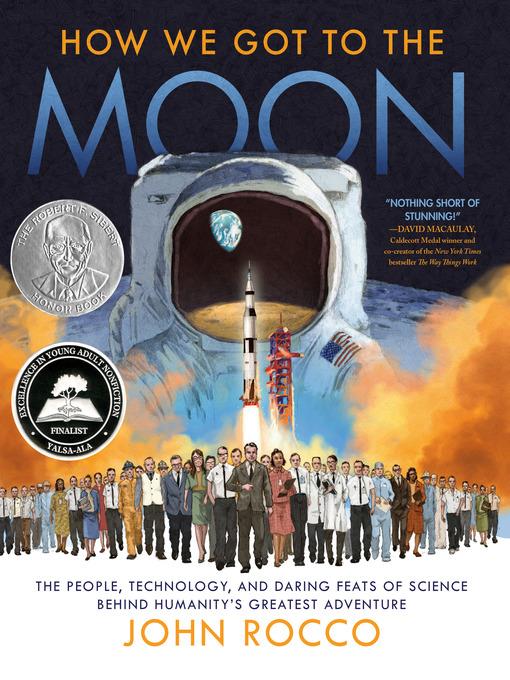
How We Got to the Moon
The People, Technology, and Daring Feats of Science Behind Humanity's Greatest Adventure
فرمت کتاب
ebook
تاریخ انتشار
2020
Lexile Score
1170
Reading Level
7-9
ATOS
8.3
Interest Level
6-12(MG+)
نویسنده
John Roccoشابک
9780525647430
کتاب های مرتبط
- اطلاعات
- نقد و بررسی
- دیدگاه کاربران
نقد و بررسی

Starred review from August 15, 2020
A dramatic, meticulous record of the U.S. space program's greatest achievement (so far). Systematically describing major components of the Saturn V and Apollo capsules, each onboard instrument, and the central NASA support facilities, Rocco orchestrates a grand overview that mingles analyses of daunting challenges and technical problems with appreciative nods to some of the 400,000 scientists and industrial workers who faced and solved them. Tucking in explanations of orbital physics and other background along the way from Sputnik to Apollo 11 (the other Apollo missions are summarized at the end), he highlights both techno-triumphs, from humongous rockets to the icky but ingenious in-flight Fecal Collection System, as well as the crucial but unsung labors of capsule designer Max Faget and dozens of others. Wary of turning the heavily illustrated pages into busy thickets of extraneous detail, the Caldecott honoree mixes his own cleanly drawn conceptualizations and cutaway views with repainted (mostly color) versions of period photographs, documents, portraits, and renowned shots like Earthrise. With a main narrative composed in the present tense, the result gives the insights, events, disasters, and near disasters of over a half-century ago not only visual unity, but an immediacy that will sweep readers along--and serve as a constant reminder that the participants, from well-known names like Katherine Johnson to geologist Farouk El-Baz and seamstress Ellie Foraker, weren't all White men or remote historical figures. A soaring tribute. (author's notes, sources, further reading, acronyms, index, map) (Nonfiction. 10-14)
COPYRIGHT(2020) Kirkus Reviews, ALL RIGHTS RESERVED.

September 1, 2020
Gr 5 Up-This illustrated nonfiction book depicts each step of the scientific and engineering journey that facilitated the moon landing. The history of the Apollo program takes a back seat to the explanations of various rocket science concepts. This is often presented in a problem-and-solution format, which adds a narrative aspect to the otherwise technical texts. The hand-drawn illustrations move from portraits to technical drawings with remarkable ease. Every page provides graphic features, including illustrations or callout boxes. Many graphics-heavy nonfiction books can be overwhelming, but this work's aesthetic is classic and coordinated. The stories of the people and their process are given as much weight as the many diagrams and engineering marvels. Several of the collage illustrations and individual profiles show the people of color and women who helped with the NASA program while acknowledging the overall lack of diversity and problems within both the time period and institution. There are a lot of books about the Apollo program, but this one offers many unique elements that make it a good addition to a collection. VERDICT A gorgeously illustrated nonfiction book about the Apollo program and the space race that does its best to highlight diversity and the human story but focuses primarily on engineering. An engaging second-level purchase for medium and larger libraries.-Elizabeth Nicolai, Anchorage P.L., AK
Copyright 2020 School Library Journal, LLC Used with permission.

Starred review from September 28, 2020
This expansive illustrated history of the Apollo space program delves ambitiously into the collective efforts and engineering feats required to send the first astronauts to the moon. In David Macaulay-esque style, pages brim with labeled diagrams, close-ups, and cutaways showcasing myriad technologies, including the inner workings of a rocket engine and the intricacies of spacesuit design. The book’s seven sections profile many lesser-known scientists,
engineers, technicians, and seamstresses who comprised a workforce 400,000 strong. Scientific principles also get full billing, often accompanied by simple experiments easily conducted at home. Using realistic colorized drawings—many replicated from archival documents and photos—Rocco (Big Machines) maintains a
consistent, accessible aesthetic throughout, while present-tense narration creates an exigent tone. In a culminating chapter about the Apollo 11 mission, for example, everyone involved “hop and pray that the parts they built, the stitches they sewed, and the programs they wrote and wove will all work perfectly.” This paean to ingenuity and collaboration, which also functions as a rocket science primer, is nothing short of stellar. Research notes, extensive source lists, a further reading list, acronyms, and an index conclude. Ages 10–up.

























دیدگاه کاربران